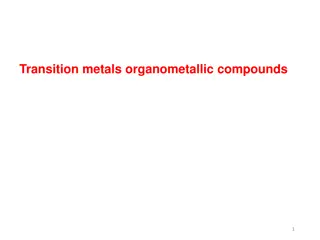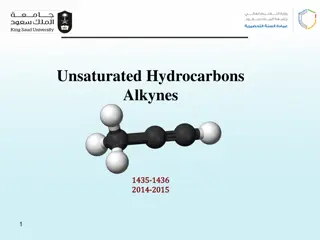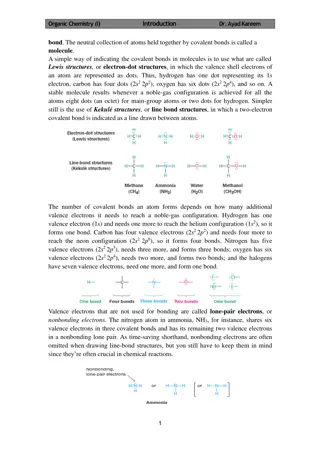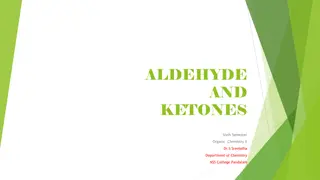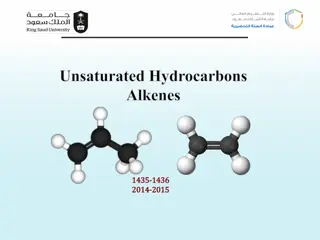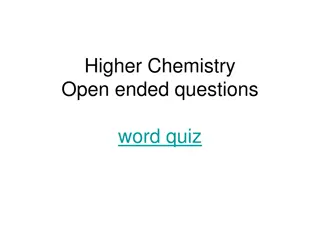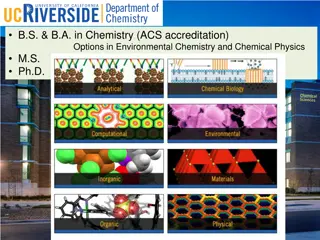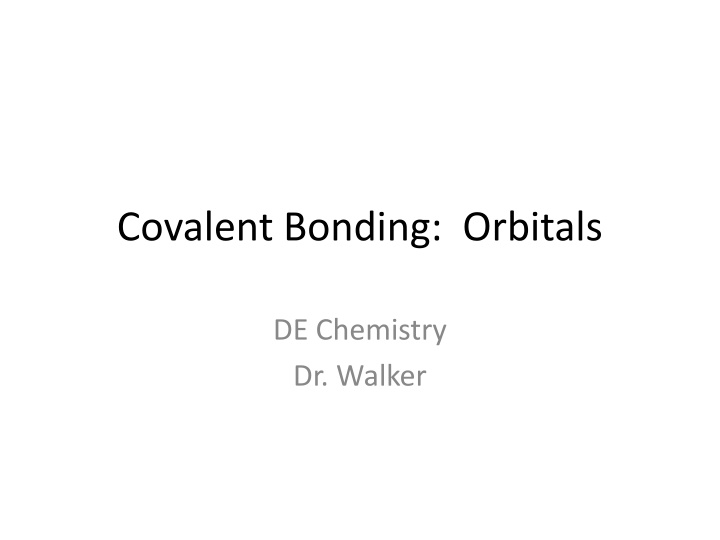
Hybridization in Chemistry
Concept of hybridization in chemistry where atomic orbitals combine to form new orbitals of equal energy, essential for explaining molecular structures and bonding behaviors.
Download Presentation

Please find below an Image/Link to download the presentation.
The content on the website is provided AS IS for your information and personal use only. It may not be sold, licensed, or shared on other websites without obtaining consent from the author. If you encounter any issues during the download, it is possible that the publisher has removed the file from their server.
You are allowed to download the files provided on this website for personal or commercial use, subject to the condition that they are used lawfully. All files are the property of their respective owners.
The content on the website is provided AS IS for your information and personal use only. It may not be sold, licensed, or shared on other websites without obtaining consent from the author.
E N D
Presentation Transcript
Covalent Bonding: Orbitals DE Chemistry Dr. Walker
Hybridization and the Localized Electron Model Hybridization The mixing of two or more atomic orbitals of similar energies on the same atom to produce new orbitals of equal energies Mixes s, p, and/or d orbitals when covalently bonded Hybrid Orbitals Orbitals of equal energy produced by the combination of two or more orbitals on the same atom
Hybridization - The Blending of Orbitals + = Poodle + Cocker Spaniel = Cockapoo + = sp orbital s orbital + p orbital =
Why Hybridization? Think of the electrons involved in bonding . Typically, most bonding occurs between electrons in sandp orbitals These orbitals are all valence electrons, so all are involved in bonding
Why Hybridization? Think about carbon . We know carbon needs to make four covalent bonds to complete its octet and become stable Two electrons are at one energy level and two electrons are at another energy level
Things we know. In methane, the electrons in hydrogen s 1s orbital bond with the orbitals in the second energy level of carbon
Houston, we have a problem. We know that all of the C-H bonds in methane are identical If two bonds are made with electrons in 2s and two with electrons in 2p, these bonds SHOULD be at different energies . How can we explain this?
The Rationalization How can we explain this? Hybridization is the combining of two or more orbitals of nearly equal energy within the same atom into orbitals of equal energy.
In the case of methane, they call the hybridization sp3, meaning that an s orbital is combined with three p orbitals to create four equal hybrid orbitals. 2sp3 2sp3 2sp3 2sp3 1s These new orbitals have slightly MORE energy than the 2sorbital and slightly LESS energy than the 2p orbitals.
Notice the tetrahedral arrangement of sp3 orbitals on the right correspond with the molecular geometry of methane and other AX4 type molecules, with bond angles of 109o (assuming no unbonded electron pairs).
sp2 Hybridization Another hybrid is the sp2, which combines two orbitals from a p sublevel with one orbital from an s sublevel. One of the p orbitals is not used in hybridization Energy diagram of sp2 orbitals
sp2 Hybridization This hybridization results in bond angles of 120o, consistent with trigonal planar geometries
sp2 Hybridization 3 effective pairs of electrons surround the carbon (double bond treated as one effective pair) In boron compounds, the unused p orbital is empty
and bonds bonds Occupies space directly between atoms bonds Occupies space above and below atoms from the overlap between two p orbitals The picture on the left represents a double bond, which uses one and one bond
Notice the sp2 geometry on the left. The single bonds in ethene are bonds. Notice the unhybridized p orbital on the left, which forms the bond shown in the previous slide.
sp Hybridization As you can probably guess this is a hybrid of one s and one p orbital, with 2 p orbitals remaining unhybridized. In the previous example, the unhybridized p orbitals made the double bond. In this case, two unhybridized p orbitals results in a triple bond between carbons (one bond, two bonds.
sp Hybridization The three different p orbitals (px, py, pz) are oriented on each axis of space. If only one p orbital hybridizes, it results in a 180o angle. This is consistent with linear molecules.
sp Hybridization sp Hybridization of carbon in ethyne.
sp Hybridization sp Hybridization of carbon in carbon dioxide.
dsp3 Hybridization Forms for central atoms requiring a trigonal bipyramidal arrangement Examples PCl5, other pentavalent atoms that disobey the octet rule Allows bonding of extra electrons that require more than the s and p orbitals (8 electrons) allow
d2sp3 Hybridization Used for hexavalent atoms with 12 bonded electrons, requiring an octahedral arrangement
Hybridization and Molecular Geometry Hybridization of A sp sp2 sp3 dsp3 d2sp3 Forms AX2 AX3, AX2E AX4, AX3E, AX2E2 AX5, AX4E, AX3E2, AX2E3 AX6, AX5E, AX4E2 Overall Structure Linear Trigonal Planar Tetrahedral Trigonal bipyramidal Octahedral A = central atom X = atoms bonded to A E = nonbonding electron pairs on A
Shortcomings of the Localized Electron Model Assumes electrons are localized (thus the name ) Doesn t really explain resonance Doesn t work well for unpaired electrons Doesn t give any indication of bond energy
Molecular Orbital (MO) Theory Molecular Orbitals Similar to atomic orbitals, but for molecules Can hold two electrons with opposite spins Square of the orbital's wave function indicates electron probability
Hydrogen Two possible bonding orbitals, shapes determine by 2 Bonding takes place in MO1 in which electrons achieve lower energy (greater stability), with electrons between the two nuclei
Hydrogen Both orbitals are in line with the nuclei, so they are (same as in localized model) molecular orbitals Higher energy orbital is designated as antibonding (*) Electron configuration of H2 can be written as 1s2
Bond Order Bond order is the difference between the number of bonding electrons and the number of antibonding electrons, divided by two Larger bond order = greater bond strength greater bond energy shorter bond length Typically, molecules with a bond order = 0 don t actually exist
Bonding in Homonuclear Diatomic Molecules In order to participate in molecular orbitals, atomic orbitals must overlap in space Larger bond order is favored When molecular orbitals are formed from p orbitals, s orbitals are favored over p orbitals (s interactions are stronger than p interactions) Electrons are closer to the nucleus = lower energy
Note Regarding MO Theory In the localized electron model, hybrid orbitals are formed by mixing s, p, and d orbitals for bonding There is no hybridization in MO theory. Electrons in s orbitals bond with each other (forming bonds) and electrons in p orbitals bond with each other (forming and bonds)
B2 Molecule Notice that s and p orbitals do not mix when bonding to form molecular orbitals There are 4 total bonding electrons and 2 antibonding electrons Bond order = (4-2)/2 = 1, making this a stable molecule The figure shown on the right is the expected arrangement, but fails to account for certain physical properties of B2.
Paramagnetism Magnetism can be induced in some nonmagnetic materials when in the presence of a magnetic field Paramagnetism causes the substance to be attracted into the inducing magnetic field Associated with unpaired electrons Diamagnetism causes the substance to be repelled from the inducing magnetic field Associated with paired electrons
Observations Regarding Paramagnetism Bond order does not necessarily equal number of bonds, as B2 has a triple bond, yet its bond order is 1. If you re paying attention, the s and p molecular orbital energies are reversed from the expected arrangement shown previously for B2. This alteration to the model explains B2 s paramagnetic behavior. In the expected arrangement shown earlier, B2 should have been diamagnetic .but it isn t.
Bonding in Heteronuclear Diatomic Molecules Similar, but not identical atoms Use molecular orbital diagrams for homonuclear molecules Significantly different atoms Each molecule must be examined individually There is no universally accepted molecular orbital energy order
Bonding in Heteronuclear Diatomic Molecules Example: NO Nitrogen has 5 valence electrons, oxygen has 6, giving 11 total Bond order = (8-3)/2 = 2.5 With an unpaired electron we expect this to be paramagnetic (and it is)
Bonding in Heteronuclear Diatomic Molecules Example: CN Carbon has 4 valence electrons, oxygen has 6, giving 10 total Bond order = (8-2)/2 = 3 With no unpaired electrons we expect this to be diamagnetic (and it is)
Combining Models Resonance Attempt to draw localized electrons in a structure in which electrons are not localized bonds can be described using localized electron model bonds (delocalized) must be described using the molecular orbital model
Benzene bonds (C - H and C - C) are sp2 hybridized Uses localized model bonds are a result of remaining p orbitals above and below the plane of the benzene ring Uses delocalized model (MO)
Representations of Benzene The bonding system with carbon s sp2 orbital system demonstrates the localized bonding model
Representations of Benzene The non-hybridized p orbitals used to make bonds above and below the ring show the need for a delocalized model where resonance is necessary

